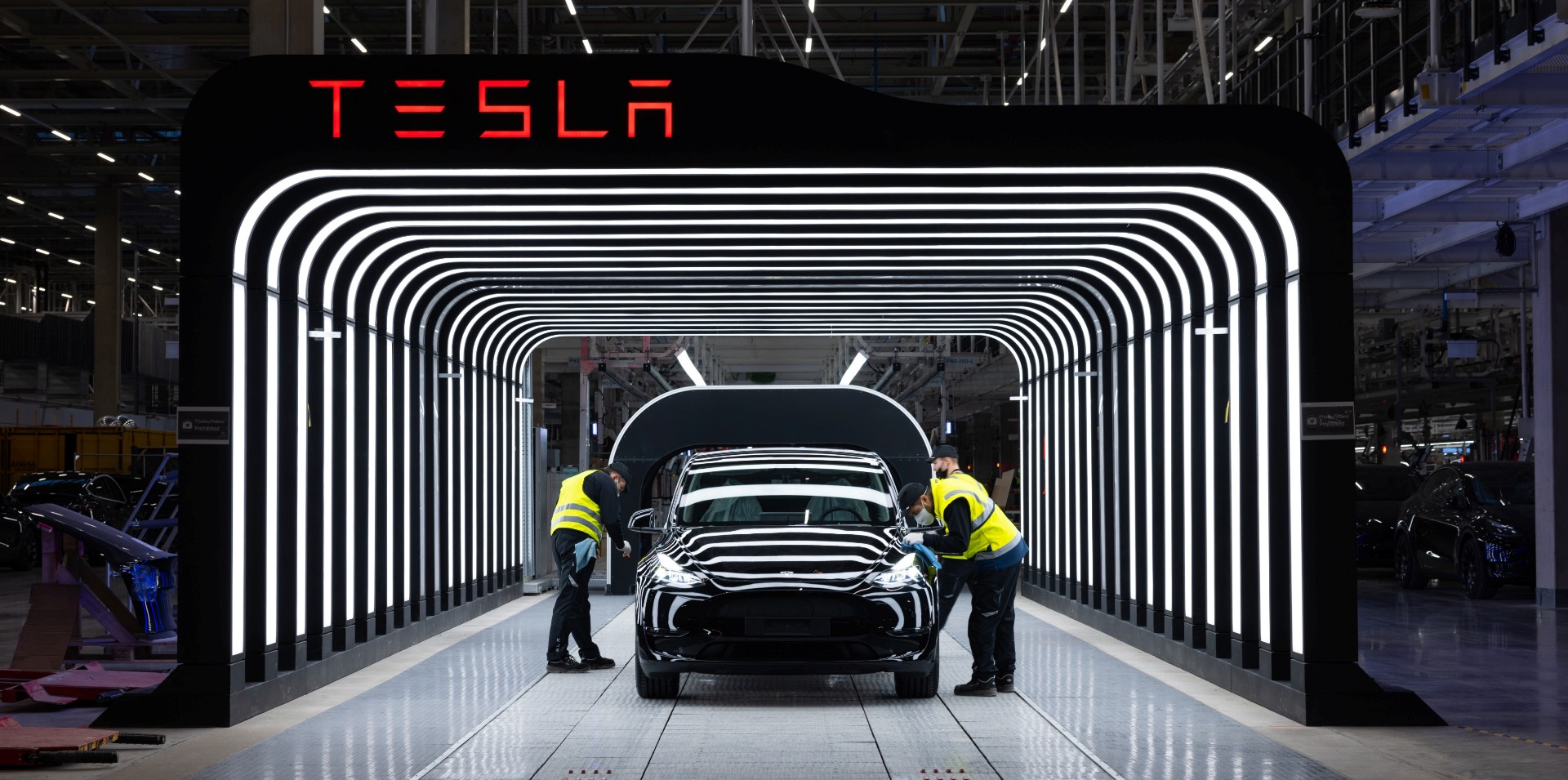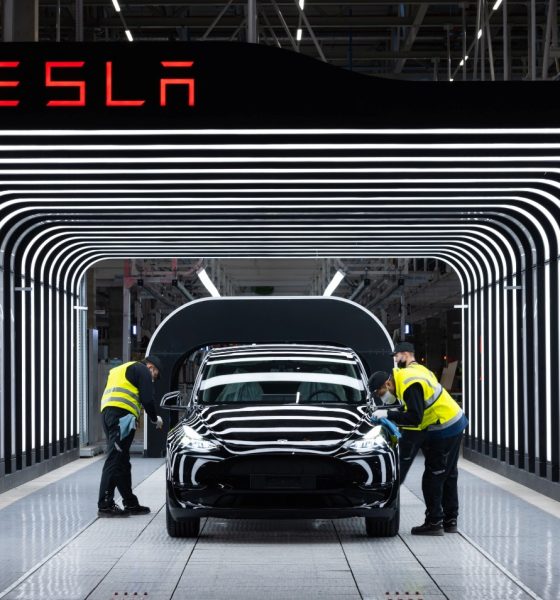

News
Tesla set to build batteries at Giga Berlin faster than previously thought, despite recent reports
Tesla is still planning to build electric vehicle battery cells in Germany at Giga Berlin, and faster than previously projected. This contradicts reports earlier this week that Tesla was delaying battery production in Germany with intentions to prioritize cell manufacturing in the United States, which would help the automaker benefit from recent government incentives.
Earlier this week, the Wall Street Journal reported Tesla was planning to delay battery cell production outside of the United States as recently-signed tax credit plans benefit domestic battery manufacturing. Citing people familiar with the matter, the WSJ claimed cell production equipment in Germany was potentially being shipped to the United States as the battery manufacturing plans had taken a drastic turn.
German Minister responds to reports of Tesla’s alleged updates to Giga Berlin battery plans
However, Tesla indirectly debunked the reports, according to German media outlet RBB24 on Friday (via Google Translate):
“The U.S. car manufacturer Tesla continues to produce batteries in Grünheide (Oder-Spree) in Brandenburg. The U.S. electric car manufacturer said this to third parties according to rbb information on Friday.”
The translation is slightly incorrect, as Tesla does not currently build battery cells in Germany.
The report also states that it is prioritizing U.S. production, but battery manufacturing systems and machinery has already been installed in Giga Berlin. It plans to begin battery production sometime early next year.
The battery manufacturing facility will provide cells for Tesla’s all-electric vehicles built at Giga Berlin, the automaker’s European production facility. Giga Berlin currently produces the Model Y crossover.
The battery facility will reportedly create 2,000 jobs in Grunheide, the municipality where the factory is located.
How U.S. battery production will benefit Tesla
According to the new stipulations of the EV tax credit, which is tied to the introduction of the Inflation Reduction Act, starting in 2023, EVs will only qualify for certain credits if the battery used in them meets certain conditions (via Congressional Research Service):
- Critical Minerals ($3,750): Starting in 2023 (and after the Treasury issues guidance on this requirement), to qualify for this portion of the credit, at least 40% of the value of the battery’s applicable critical minerals must have been extracted or processed in the United States or in a country with which the United States has a free trade agreement, or recycled in North America. The 40% amount increases to 50% in 2024, 60% in 2025, 70% in 2026, and 80% in 2027 and thereafter.
- Battery Components ($3,750): Starting in 2023 (and after the Treasury issues guidance on this requirement), to qualify for this portion of the credit, at least 50% of the value of the battery’s components must have been manufactured or assembled in North America. The 50% amount increases to 60% in 2024 and 2025, 70% in 2026, 80% in 2027, 90% in 2028, and 100% in 2029 and thereafter.
Tesla is going to benefit from these tax credits anyway, as it plans to build battery cells at its Gigafactory Texas production plant just outside Austin.
Tesla also manufactures the 4680 cells at a facility near the Fremont Factory in Northern California. Teslarati recently reported that Tesla filed to build battery cell manufacturing equipment at the Fremont Factory, where it currently does not manufacture cells.
I’d love to hear from you! If you have any comments, concerns, or questions, please email me at joey@teslarati.com. You can also reach me on Twitter @KlenderJoey, or if you have news tips, you can email us at tips@teslarati.com.

Elon Musk
Elon Musk just said some crazy stuff about the Tesla Roadster

Elon Musk appeared on the Moonshots podcast with Peter Diamandis today to discuss AGI, U.S. vs. China, Tesla, and some other interesting topics, but there was some discussion about the upcoming unveiling of the Roadster, the company’s electric supercar that will arrive several years after it was initially slated for release.
Musk made some pretty amazing claims about the Roadster; we already know it is supposed to be lightning-fast and could even hover, if Tesla gets everything to happen the way it wants to. However, the car has some pretty crazy capabilities, some of which have not even been revealed.
On the podcast, Musk said:
“This is not a…safety is not the main goal. If you buy a Ferrari, safety is not the number one goal. I say, if safety is your number one goal, do not buy the Roadster…We’ll aspire not to kill anyone in this car. It’ll be the best of the last of the human-driven cars. The best of the last.”
🚨 Elon on the Roadster unveiling, scheduled for April 1:
— TESLARATI (@Teslarati) January 6, 2026
Musk makes a good point: people who buy expensive sports cars with ridiculous top speeds and acceleration rates do not buy them to be safe. They hope they are safe in case of an emergency or crash, but safety is not at the forefront of their thoughts, because nobody buys a car thinking they’ll crash it.
The Roadster is truly going to push the limits and capabilities of passenger vehicles; there’s no doubt about that. Tesla plans to show off the new version car for the first time on April 1, and Musk has only hinted at what is possible with it.
Musk said back in November:
“Whether it’s good or bad, it will be unforgettable. My friend Peter Thiel once reflected that the future was supposed to have flying cars, but we don’t have flying cars. I think if Peter wants a flying car, he should be able to buy one…I think it has a shot at being the most memorable product unveiling ever. [It will be unveiled] hopefully before the end of the year. You know, we need to make sure that it works. This is some crazy technology in this car. Let’s just put it this way: if you took all the James Bond cars and combined them, it’s crazier than that.”
Production is set to begin between 12 and 18 months after the unveiling, which would put the car out sometime in 2027. Hopefully, Tesla is able to stay on track with the scheduling of the Roadster; many people have been waiting a long time for it.
News
Tesla launches hiring for Robotaxi program in its twentieth country
Overall, the hiring signals Tesla’s aggressive timeline for global dominance in autonomous mobility.

Tesla has launched a hiring initiative for its Robotaxi program in its twentieth country, as the company posted two new jobs in Thailand this week.
Tesla is hiring in Bangkok and Kowloon for the Vehicle Operator position, which is related to data collection, and is the first in Thailand, but the twentieth country overall, as the company tries to expand into other markets.
🚨 BREAKING: Tesla is hiring additional full-time Vehicle Operators in Bangkok, Thailand.
Previous openings were 6-month, part-time roles. These are equivalent to AI Safety Operator roles in the U.S. pic.twitter.com/R6LzoU1bos— Tesla Yoda (@teslayoda) January 5, 2026
Tesla has had active job postings for Vehicle Operator positions in the United States, India, Israel, Taiwan, Germany, the Czech Republic, Hungary, the UK, Finland, Switzerland, Sweden, the Netherlands, Austria, Spain, Norway, Italy, and Turkey in past listings.
These postings are not all currently available, likely because the roles have been filled.
Thailand is the most recent, and broadens the company’s potential path to expanding its ride-hailing program, which is only active in the United States in Austin, Texas, and the California Bay Area, so far.
These roles typically involve data collection, which assists in improving Autopilot and Full Self-Driving operation. Tesla’s self-driving programs utilize real-world data that is accumulated and stored, observing vehicle and traffic behavior, as well as tendencies that are performed by human drivers to help increase safety and overall performance.
Overall, the hiring signals Tesla’s aggressive timeline for global dominance in autonomous mobility. Although the company has several high-profile rivals and competitors in the field, it has established itself as a main player and a leader in the development of autonomous technology, especially in the U.S., as its FSD suite is refined on almost a weekly basis.
The Full Self-Driving suite is available in seven countries and territories currently, including the U.S., Canada, China, Mexico, Puerto Rico, Australia, and New Zealand. Its biggest goal for expansion is currently the European market, where regulatory hurdles have been the main bottleneck prolonging its launch on the continent.
Tesla has performed months of testing in various European countries, including France and Spain, and does have support in some areas from various regulatory agencies. However, the company is hoping to get through this red tape and offer its suite in Europe for the first time, hopefully this year.
News
Tesla China rolls out Model Y upgrades, launches low-interest financing
These strategies are aimed at improving the ownership experience and keeping vehicle pricing competitive in the world’s largest electric vehicle market.

Tesla has rolled out minor updates to the five-seat Model Y in China, upgrading the vehicle’s center display to a higher-resolution 16-inch 2K screen. The electric vehicle maker also introduced attractive financing options, including 7-year low-interest rates, to offset the new purchase tax on EVs.
These strategies are aimed at improving the ownership experience and keeping vehicle pricing competitive in the world’s largest electric vehicle market.
Five-seat Model Y gets larger, better display
With its recent update, all three variants of the five-seat Model Y now feature an upgraded 16-inch 2K resolution center display, which replaces the vehicle’s previous 15.4-inch 1080p panel. This screen was already used in the six-seat Model Y L, and it offered improved visual clarity. Tesla China has also updated the Model Y’s headliner to black, giving the vehicle a sleeker appearance.
Prices of the five-seat Model Y remain unchanged at RMB 263,500, RMB 288,500, and RMB 313,500 for the respective trims. This update enhances the cabin experience as domestic rivals are already adopting high-resolution screens. As noted in a CNEV Post report, some domestic automakers have begun rolling out vehicles equipped with 3K-resolution displays.
New financing offers
Tesla also launched ultra-long-term financing offers for its locally produced models in China, which include the Model 3 sedan, the five-seat Model Y, and the six-seat Model Y L, through January 31, 2026. The 7-year option features an annualized fee rate as low as 0.5%, which is equivalent to 0.98% interest. This is expected to save customers up to RMB 33,479 ($4,790) compared to standard rates.
A 5-year zero-interest plan is also available, and it has been extended to the Tesla Model Y L for the first time. These incentives help offset China’s new 5% purchase tax on New Energy Vehicles (NEVs) in 2026-2027. Some of Tesla’s rivals in China have announced in recent months that they would be covering the purchase tax owed by buyers early this year.








